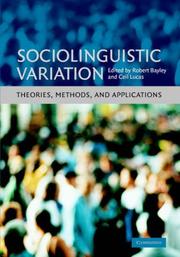| Listing 1 - 2 of 2 |
Sort by
|

ISBN: 9780521871273 9780521691819 0521691818 9780511619496 9780511367601 0511367600 0511366388 9780511366383 0511619499 9786611146221 6611146229 0521871271 1281146226 9781281146229 0511367015 9780511367014 0511365756 9780511365751 0511573642 9780511573644 1107180287 9781107180284 Year: 2007 Publisher: Cambridge Cambridge university press
Abstract | Keywords | Export | Availability | Bookmark
 Loading...
Loading...Choose an application
- Reference Manager
- EndNote
- RefWorks (Direct export to RefWorks)
Why does human language vary from one person, or one group, to another? In what ways does it vary? How do linguists go about studying variation in, say, the sound system or the sentence structure of a particular language? Why is the study of language variation important outside the academic world, in say education, the law, employment or housing? This book provides an overview of these questions, bringing together a team of experts to survey key areas within the study of language variation and language change. Covering both the range of methods used to research variation in language, and the applications of such research to a variety of social contexts, it is essential reading for advanced students and researchers in sociolinguistics, communication, linguistic anthropology and applied linguistics.
Sociolinguistics --- Dialectology --- Language and languages --- Variation --- Sociolinguistics. --- Variation. --- Sociolinguïstiek --- Taalvarianten --- Taalverandering --- Sociolinguïstiek. --- Taalvarianten. --- Taalverandering. --- Language and society --- Society and language --- Sociology of language --- Language and culture --- Linguistics --- Sociology --- Integrational linguistics (Oxford school) --- Characterology of speech --- Language diversity --- Language subsystems --- Language variation --- Linguistic diversity --- Variation in language --- Social aspects --- Sociological aspects --- Arts and Humanities --- Language & Linguistics --- Variation linguistique --- Language and languages - Variation --- Sociolinguistique
Multi
ISBN: 9781107280298 9781107051942 9781107663862 1316234592 131623648X 110728029X Year: 2015 Publisher: Cambridge Cambridge University Press
Abstract | Keywords | Export | Availability | Bookmark
 Loading...
Loading...Choose an application
- Reference Manager
- EndNote
- RefWorks (Direct export to RefWorks)
How do people use sign languages in different situations around the world? How are sign languages distributed globally? What happens when they come in contact with spoken and written languages? These and other questions are explored in this new introduction to the sociolinguistics of sign languages and deaf communities. An international team brings insights and data from a wide range of sign languages, from the USA, Canada, England, Spain, Brazil and Australia. Topics covered include multilingualism in the global deaf community, sociolinguistic variation and change in sign languages, bilingualism and language contact between signed and spoken languages, attitudes towards sign languages, sign language planning and policy, and sign language discourse. Sociolinguistics and Deaf Communities will be welcomed by students of sign language and interpreting, teachers of sign language, and students and academics working in linguistics.
Sociolinguistics --- Sign language --- Sign language. --- Deaf --- Sociolinguistics. --- Means of communication.
| Listing 1 - 2 of 2 |
Sort by
|

 Search
Search Feedback
Feedback About UniCat
About UniCat  Help
Help News
News